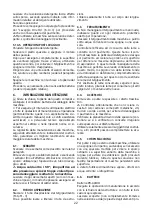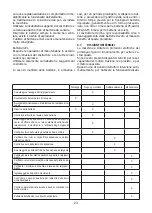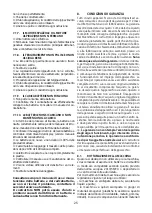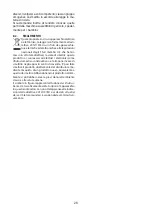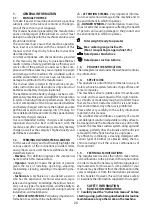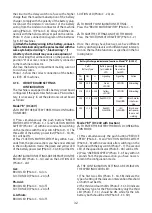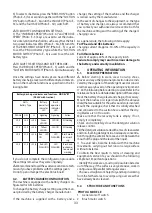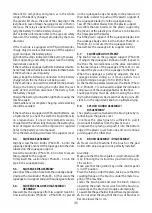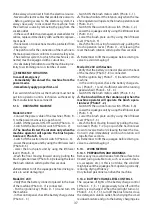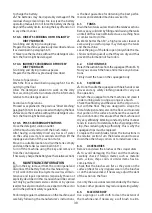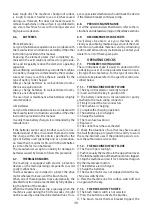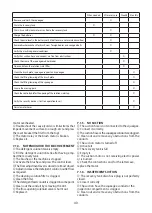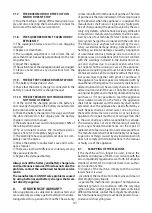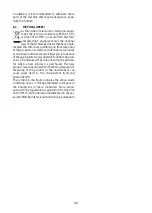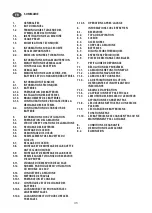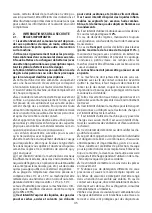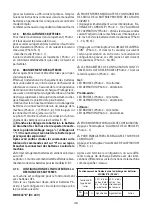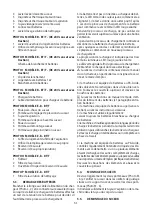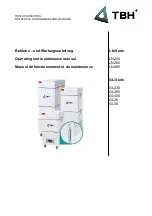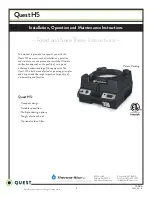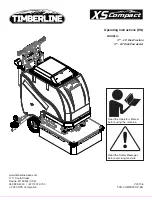
36
•
Do not allow the thickness of the abrasive disks to
become less than 1 cm.
Working with excessively worn brushes or excessively thin
abrasive disks may damage the machine and the floor.
Regularly check the wear on these parts before start-
ing to work.
Disassembly or replacement:
Make sure that the brush plate is raised; otherwise lift
it by following the instructions provided in the spe-
cific section.
Make sure that the ignition key on the control panel is
in position OFF position.
While holding the brush with the hands under the
plate, turn it in the rotation direction while lowering
to release it from the metal coupling on the machine.
To disassemble the pad holder follow the same pro-
cedure.
5.10. FILLING AND DRAINING THE SOLUTION
TANK
•
The temperature of the water or the detergent
should never exceed 50°C.
☞
Always empty the recovery tank ( Photo N - 4) be-
fore filling the solution tank ( Photo N - 3).
To fill the tank:
- Pour into the tank the required quantity of the
chemical product, considering the percentage indi-
cated by the supplier, with reference to the full tank
capacity listed on the product sheet.
•
Use only those products suitable for the floor and
the dirt to be removed.
- Pour water in the filling opening placed in the front
of the machine ( Photo H - 2, Photo N - 2 ).
Leave 2 cm between the filling opening and the liquid
level. Do not fill beyond this point!
•
The machine was designed to be used with
non-foaming and biodegradable detergents made
specifically for scrubber-driers. The use of other
chemical products (such as sodium hypochlorite,
oxidizers, solvents or hydrocarbons) may damage or
destroy the machine.
- Follow the safety regulations specified in the relative
section and indicated on the detergent container.
- Contact the machine manufacturer to obtain a com-
plete list of available and suitable detergents.
- Do not leave the water hose unattended and insert
it completely into the tank: the hose might move and
get sensitive parts of the machine wet.
Close the tank with its foam plug.
To drain the tank:
- Unscrew and remove the transparent cap of filter /
regulator of the cleaning solution placed in the bot-
tom of the tank (Photo Q - 1) and wait for the com-
plete emptying.
- After draining, replace and tighten the cap.
5.11. DRAINING THE RECOVERY TANK
The dirty water must be drained in accordance with
national regulations.
The user is completely responsible for ensuring com-
pliance with such rules.
After the detergent solution is finished, always empty
the recovery tank ( Photo N - 3) before filling it again.
In general, the recovery tank can be emptied when-
ever required, and even during intermediate phases
of the work cycle.
The recovery tank volume is higher than the deter-
gent solution volume, therefore a potentially dan-
gerous situation for the suction motor should never
occur. In any case, a safety float ( Photo O - 1) will stop
the suction if the dirty liquid level is too high.
•
If water or foam starts leaking from under the
tanks for any reason, immediately turn off the suction
motor and empty the recovery tank.
To drain the tank:
Drive the machine to a suitable location to drain the
dirty water and preferably near a toilet or a sewer
drain (comply with the national regulations for waste
water disposal).
Turn off the machine and remove the key from the panel.
Detach the drain hose from the holder ( Photo B - 6,
D - 6, F - 7 ) and, keeping it high, unscrew the plug.
Lower the drain hose toward the selected drainage point.
The emptying operation can be interrupted quickly
and whenever required just by raising the drain hose.
Check how much dirt is still in the tank and, if nec-
essary, wash it inside through the inspection hole (
Photo O - 3).
Fully tighten the drain hose with the screw plug and
hang it on the support behind the machine. The drain
hose plug must be airtight, otherwise the subsequent
pressure loss will reduce drying efficiency.
5.12. SPECIFIC INSTRUCTIONS FOR THE USE OF
MODEL AC 230V
The AC 230V model machine may be turned on only
if the voltage indicated on the tag corresponds with
the available voltage and that the electrical outlet is
grounded (earthed).
Do not damage the feed cable; do not crush or pull on it.
•
ATTENTION Make sure that the power cable does
not come into contact with the rotary brushes.
•
ATTENTION !!! - The model AC 230V machine
has parts, which are connected to the current;
contact with these could cause grave injuries or
even death.
- Before executing any type of operation on the ma-
Summary of Contents for Fasa A5 EVO 50
Page 3: ...3 2 1 3 A B 6 1 3 4 5 2 E AC 230V...
Page 4: ...4 C D 2 2A 3A 3B 3C 1A 1 3 6 3 4 5 1 8 2 B DC 24V 7...
Page 6: ...6 H G 1 2 1 3 2 I...
Page 7: ...7 1 2 L M 1 1 4 4 3 2 5 7 6 5 2 6...
Page 8: ...8 N O 1 1 2 3 3 2 4...
Page 9: ...9 P 1...
Page 95: ...95 1 1 1 1 2 2 10 1 3 1 4...
Page 96: ...96 1 5 2 2 1 4 35 10 50 30 95 2 10...
Page 97: ...97 2 2...
Page 98: ...98 3 3 1 3 2 3 3 C C 3 4...
Page 99: ...99 4 4 1 4 1 1 20 20 20h 5 5 5h 5 5 20 20 24 4 1 2 4 1 3 I 2 G 1 3 I 1 I 2...
Page 104: ...104 5 4 M 6 M 6 M 3 5 5 M 6 5 6 6 5 M 4 M 6 M 4 M 6 6 4 5 7 M 2 45 M 2 M 7 5 8 5 9...
Page 105: ...105 1 1 5 10 50 C 3 4 2 2 2 P 1 5 11 3 1...
Page 106: ...106 5 D 6 F 7 3 5 12 AC 230V AC230 AC 230V 5 13 230V 1 1 ON 2 B 5 A 3 3 2 4 DC 24V D 7 D 1 3 1...
Page 108: ...108 6 11 6 6 1 50 6 2 M 3 6 3 6 4 6 5 6 6...
Page 109: ...109 6 7 6 8 6 8 1 6 8 2 6 8 3 6 9...
Page 110: ...110 7 7 1 7 1 1 1 C 30 7 1 2 5 7 1 3 7 1 4 7 1 5 7 1 6 7 1 7...
Page 111: ...111 7 1 8 7 1 9 7 1 10 100 20 30 8 12 8 1 2013 56 EU...
Page 112: ...112 8 2 2012 19 EU 2012 19 EU...
Page 130: ...130 8...
Page 131: ...131 7 3 12...
Page 132: ...132 6...
Page 133: ...133 5 2 10...
Page 134: ...134 4 4 35 10 50 30 95...
Page 135: ...135 3 5 1 CE CE 2 1 2...
Page 136: ...136 2 3 1 CE 4 1...
Page 137: ...137 1 1 1 1 1 2...
Page 153: ...153...
Page 231: ...231...
Page 247: ...247 1 1 1 1 2 2 10 1 3 a 1 4...
Page 248: ...248 1 5 2 2 1 4 C 35 C 10 C 50 C 30 95 2 10...
Page 249: ...249 2 2 3 3 1 3 2 3 3...
Page 250: ...250 3 4 4 4 1 Ah 20 C20 20h 5 C5 5h C5 C20 Pb Acid...
Page 255: ...255 1 Pb Pb 5 4 M 6 6 M 3 5 5 6 5 6 6 5 M 4 M 6 M 4 M 6 6 4 5 7 M 7 2 45 M 2 M 7 5 8...
Page 256: ...256 5 9 OFF 1 cm 1 cm OFF 5 10 L 50 C N 4 N 3 2 N 2 2 L Q 1 5 11 N 3 0 1...
Page 259: ...6 11 6 259 6 1 50 6 2 X X X X X X X X X X X X X X X X X X...
Page 260: ...260 3 6 3 6 4 6 5 6 6 BPb 3 AGM 6 6 7...
Page 261: ...261 6 8 6 9 7 7 1 7 1 1 ON 30 7 1 2 5 7 1 3 7 1 4 7 1 5 7 1 6...
Page 262: ...262 7 1 7 7 1 8 7 1 9 7 1 10 100 20 30 8 12...
Page 263: ...263 8 1 2013 56 8 2 WEEE 2012 19 2012 19 EU...
Page 265: ...265 1 1 1 1 2 2 2 10 1 3 1 4...
Page 266: ...266 1 5 2 2 1 4 C 35 C 10 C 50 C 30 95 2 10...
Page 267: ...267 2 2 134 3 3 1 3 2 3 3...
Page 268: ...268 3 4 4 4 1 4 1 1 Ah 20 C20 20h 5 C5 5h C5 C20 24...
Page 274: ...274 5 8 5 9 1 cm 1 cm 5 10 50 C N 4 N 3 G 2 N 2 2 cm 5 11...
Page 277: ...6 13 6 14 3 5 14 5 277 6 11 6 X X X X X X X X X X X X X X X X X X...
Page 278: ...278 6 1 50 6 2 M 3 6 3 6 4 6 5 6 6...
Page 279: ...279 3 AGM 6 6 7 6 8 6 9 7 7 1 7 1 1 1 30 7 1 2 5 7 1 3 7 1 4...
Page 280: ...280 7 1 5 7 1 6 7 1 7 7 1 8 7 1 9 7 1 10 100 20 30 8 12...
Page 281: ...281 8 1 2013 56 E 8 2 2012 19 2012 19...
Page 282: ......
Page 283: ......
Page 284: ......

